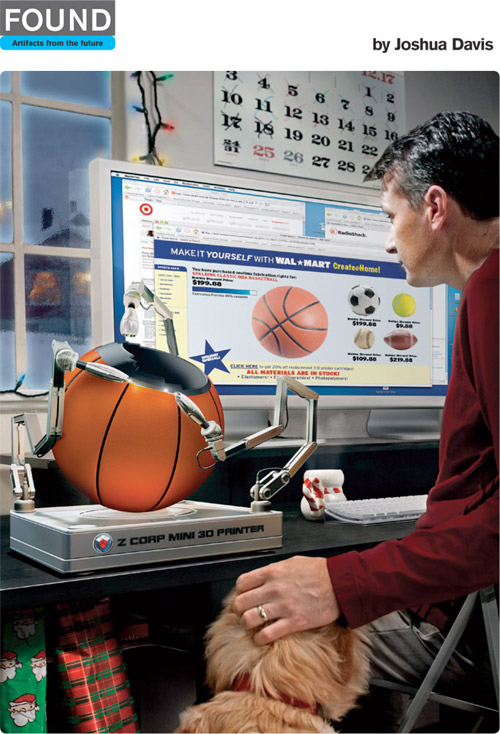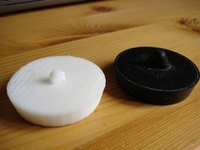RepRap network effects (draft)
The exact topic is still preliminary, but my masters research is going to be on user innovation in fabrication and its interrelation with the commercial players, their products and their customers. The creation of dispersion of knowledge is important for this matter. Of course, IP is very relevant to the interactions. IP law has an impact in diffusion of the invention, but I argue that proliferation of the technology on a massive distributed scale, will also have an effect on the IP regime. Since more serious hobbyists like myself can now have manufacturing technology at home, soon afterwards everyone will be able to have one. Because the utility of having a 3D printer will increase due to network effects (Network theory, Metcalfe’s law), there will be a demand for this. This is confirmed by the high growth rates that I have been observing. Of course I’d like to have better data to really say something about the real growth rate, but it is promising nevertheless.

Figure 1: An example used on Wikipedia to describe how word of mouth can create a reinforcing feedback loop (labeled as R)
Below I list a few observations that have positive feedback loops (network effects). This list is probably very incomplete, but still it shows the potential of open fabrication.
Machine quality:
- because of the open design, growing amounts of people will improve the machine
- quality of the manufactured products goes up (more multi-material objects)
- more variations of (printed) peripheral machines will start to be developed. Such as a recycler system to drastically reduce the demand on external resources.
- because it is used by many different people in many different settings, contributed improvements made to the design are more robust
Adoption of the manufacturing technology:
- the machine becomes more valuable to have (because of benefits in the other categories)
- the machine becomes easier to build
- the machine becomes easier to use
- parts become better available, because more people can 3D print the parts you need to make more 3D printers
- as more people have these machines, more people will see it, it will become better known that the exist and the benefits that they bring

3D printable products / content:
- quality of the designs goes up (better design tools, more mature population of designers)
- amount of experienced designers go up
- range of products available goes up (without a significant space-restriction since they’re stored and transmitted in digital form)
- publishing and sharing designs becomes easier (http://thingiverse.com)
- people are collaboratively tagging, organising and documenting 3D designs (easier to find and use)
- tools to find valuable products improve (better tagging and sites with 3D designs)
- people are exploiting the properties of the process to create products that could not be made with traditional means of production (example 1, example 2)
I haven’t mentioned any effects that haven’t kicked in already. People are printing shoes, improvements to the machine, creating offspring machines (both completely new types, variations and copies), improving physical products with peers across the globe. Thousands of people are now building these machines and telling their friends and families, who will soon want one, as soon as it’s easier to use it. People are designing scripts that will allow you to tell the computer that you want a pot with screw cap, with diameter x, height y and wall thickness z. Or to specify how big the lego-compatible blocks that you print should be. Moreover, you can export one of the 150,000+ designs on the Google 3D warehouse (searching the word ’the’ gives 143515 hits at the second of writing this).
Obviously, this has a tremendous effect on the traditionally centrally organised manufacturing of many product types. Besides manufacturing itself, the distribution of products, and eliciting product needs from users will change. If users can design and manufacture their products at home, there is no need for the entire traditional supply chain. Instead, there will be supply networks. Designers can use idea repositories for designing tools. They find this intrinsically rewarding, and are encouraged by other people printing their designs. because you only need to design something yourself if it’s not easily found online already. And after designing it, you might as well publish it and get credit, or see improvements being made. People are repairing their dishwashers with it, printing replacements for the lost stylusses for their PDA’s or repair a camera.

For many products, it is much cheaper to print one at home than to get it from a store. Especially if you include the costs to go to a store and search for it. The ‘bricks and mortar’ store has to charge for its stock keeping costs, which not only affects price, but also limits the amount of ‘low selling’ products that they can have offer. You save the trip to a store and waiting to check out. Searching for very specific products (such as the box that protects a camera lens) is much more expensive than describing it and having a toolkit creating the ready-to-print model for you. You will more precisely get what you want, without the distribution costs and the manufacturer’s profit margin, and you will get it instantly. The marginal costs of printing are slightly above the raw price of the plastics. Even for bigger objects, the price of the electricity costs of production is negligible (cents’ worth of it). The total costs would include the depreciation of the 3D printer. But what is the depreciation cost? This cannot be calculated by traditional means because of an important point. When will the machine product become obsolete? Since you can download many of the parts to make a RepRap, you can also download replacement parts, updates, extensions. Replacement parts allow you to become more independent and fix your machine if something breaks (dependability of the machine). Incremental updates allow you to do the same things better (higher speed, better precision, more reliability, etc.). Extensions allow you to do more things (make chocolate, decorate little cakes, milling and engraving of soft materials such as wood or plastics).


The amounts of materials that can be used will extend, allowing simple motors to be made and further increasing the amount of parts the machine can make. But we can already make motors (air-powered one, or parts for a DC motor). The distributed problem solving capability should not be underestimated. When it become practical to make even more of the machine, everyone who welcomes it will be able to have this increasingly powerful capability in their homes.
Recente reacties